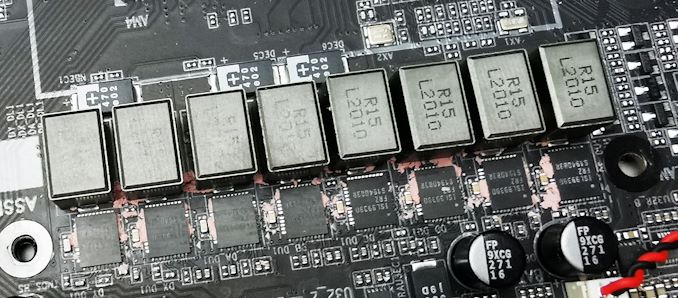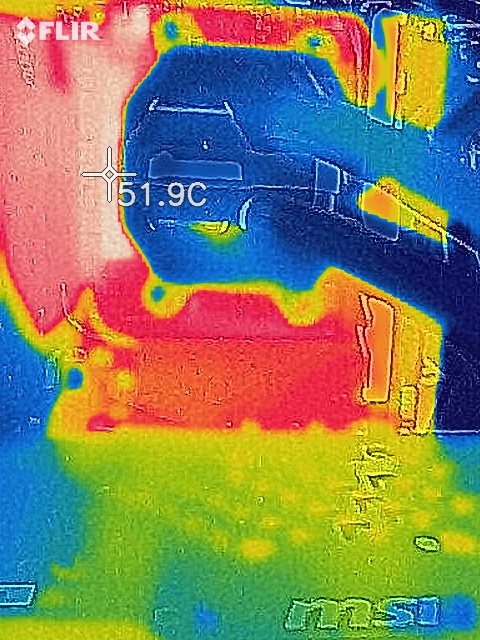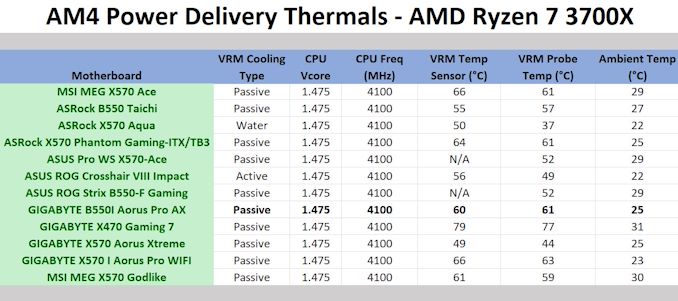The GIGABYTE B550I Aorus Pro AX Motherboard Review: All The Small Things
by Gavin Bonshor on December 7, 2020 10:00 AM ESTPower Delivery Thermal Analysis
One of the most requested elements of our motherboard reviews revolves around the power delivery and its componentry. Aside from the quality of the components and its capability for overclocking to push out higher clock speeds which in turn improves performance, is the thermal capability of the cooling solutions implemented by manufacturers. While almost always fine for users running processors at default settings, the cooling capability of the VRMs isn't something that users should worry too much about, but for those looking to squeeze out extra performance from the CPU via overclocking, this puts extra pressure on the power delivery and in turn, generates extra heat. This is why more premium models often include heatsinks on its models with better cooling designs, heftier chunks of metal, and in some cases, even with water blocks.

The 8-phase power delivery operating at 6+2 on the GIGABYTE B550I Aorus Pro AX
Testing Methodology
Out method of testing out if the power delivery and its heatsink are effective at dissipating heat, is by running an intensely heavy CPU workload for a prolonged method of time. We apply an overclock which is deemed safe and at the maximum that the silicon on our AMD Ryzen 7 3700X processor allows. We then run the Prime95 with AVX2 enabled under a torture test for an hour at the maximum stable overclock we can which puts insane pressure on the processor. We collect our data via three different methods which include the following:
- Taking a thermal image from a birds-eye view after an hour with a Flir Pro thermal imaging camera
- Securing two probes on to the rear of the PCB, right underneath CPU VCore section of the power delivery for better parity in case the first probe reports a faulty reading
- Taking a reading of the VRM temperature from the sensor reading within the HWInfo monitoring application
The reason for using three different methods is that some sensors can read inaccurate temperatures, which can give very erratic results for users looking to gauge whether an overclock is too much pressure for the power delivery handle. With using a probe on the rear, it can also show the efficiency of the power stages and heatsinks as a wide margin between the probe and sensor temperature can show that the heatsink is dissipating heat and that the design is working, or that the internal sensor is massively wrong. To ensure our probe was accurate before testing, I binned 10 and selected the most accurate (within 1c of the actual temperature) for better parity in our testing.
For thermal image, we use a Flir One camera as it gives a good indication of where the heat is generated around the socket area, as some designs use different configurations and an evenly spread power delivery with good components will usually generate less heat. Manufacturers who use inefficient heatsinks and cheap out on power delivery components should run hotter than those who have invested. Of course, a $700 flagship motherboard is likely to outperform a cheaper $100 model under the same testing conditions, but it is still worth testing to see which vendors are doing things correctly.
Thermal Analysis Results

We measured 51.9°C on the hottest part of CPU socket area during our testing
The GIGABYTE B550I Aorus Pro AX is using an 8-phase design that operates in a 6+2 configuration. It consists of six Intersil ISL99390 90 A power stages for the CPU VCore, and two ISL99390 90 A power stages for the SoC. (insert doubler). Cooling the power delivery is a large single heatsink that molds into the design of the board's plastic rear panel cover and is connected to the M.2 and chipset heatsink. It relies primarily on brute mass and good passive airflow within a chassis.
Looking at the GIGABYTE B550I Aorus Pro AX's power delivery thermal results in comparison to other AM4 models we've tested with our Ryzen 7 3700X processor, it performs pretty well all things considered. We typically see higher temperatures on mini-ITX motherboards which is a direct result of cramped componentry on a small PCB. Where an ATX size model can utilize PCB space to split power deliveries into two elements with one to two heatsinks to dissipate the heat more effectively, the GIGABYTE power delivery operates in a single strip with a single heatsink doing all of the heat removal.
We observed a reading of 61°C from our first K-type probe on the rear, with our second consistent with a slight variance of 59°C. This is also consistent with the reading from the board's VRM temperature sensor of 61°C, which shows the heatsink is efficiently removing heat as our thermal imaging camera shows the hottest part around the socket reached just shy of 52°C. This is good for a mini-ITX model and it shows GIGABYTE has another highly efficient power delivery design on its hands.











76 Comments
View All Comments
mkarwin - Tuesday, December 15, 2020 - link
It might have inferior codec setup, but allows better flexibility and connectability using the rear panel I/O audio ports...Questor - Wednesday, December 9, 2020 - link
Unfortunately for Gigabyte, the lack of a front USB-C header is a deal breaker. I had the same thought you did, hoping and holding out for a V2.Gigaplex - Wednesday, December 9, 2020 - link
How much of a dealbreaker? You can get USB3 to USB-C header adapters.Questor - Thursday, December 10, 2020 - link
Hm. I didn't think about that. Amazing how we miss things right in front of us. Not so much of a deal breaker me thinks. As long as the USB connection is reachable, since it wasn't placed as a front panel header.OliveGray - Sunday, December 13, 2020 - link
These are 2 pay checks $78367 and $87367. that i received in last 2 months. I am very happy that i can make thousands in my part time and now i am enjoying my life. Everybody can do this and earn lots of dollars from home in very short time period. Just visit this website now. Your Success is one step away Copy and Paste___bit.ly/googlework43kkilobyte - Monday, December 7, 2020 - link
Hopefully, it isn't as buggy as their X570 motherboards, that drop dead randomly and require removing the CMOS battery to be able to start it again - an issue that Gigabyte, in more than a year, never solved or even tried to solve.meacupla - Monday, December 7, 2020 - link
That seems to be a common issue on any Gigabyte motherboard.It's like their EEPROM chips have a 50% failure rate within 3yrs and 90% in 5yrs
Deicidium369 - Monday, December 7, 2020 - link
I have dozens in service - some going back to Conroe and never once have had a EEPROM die - maybe you should look at your power delivery system.Samus - Monday, December 7, 2020 - link
I’ve seen EEPROM failure on a few gigabyte boards going back to socket 939 it’s widely known to be an issue and Gigabyte seemingly knows it because they were making the first (only behind ABIT and DFI) to advocate ‘DualBIOS’ which they naturally did away with awhile back because it is expensive.star-affinity - Tuesday, December 8, 2020 - link
:-OIs that why my (or my sister's nowadays) 11 year old Gigabyte GA-EX58-UD5 behaves like this:
https://www.dropbox.com/s/f0bgoxfquiu7mky/GA-EX58-...
I've done all I know of, switching around RAM modules, remove the CMOS battery, press reset CMOS on the back. Got it to start BIOS recovery from the ”DualBIOS” once, but even during that process it turned itself off.
Could be the power supply perhaps, but I've seen other videos online of Gigabyte motherboards doing the same.